Francesco Porcia or Francesco Apollodoro (Porcia in the Friuli, 1531 - Padua, 1612) was an Italian painter, chiefly of portraits in Padua. He is suspected to have been the son or grandson of the painter Paolino Apollodoro. [1]

Francesco Porcia or Francesco Apollodoro (Porcia in the Friuli, 1531 - Padua, 1612) was an Italian painter, chiefly of portraits in Padua. He is suspected to have been the son or grandson of the painter Paolino Apollodoro. [1]


Castelfranco Veneto is a town and comune of Veneto, northern Italy, in the province of Treviso, 30 kilometres by rail from the town of Treviso. It is approximately 40 km (25 mi) inland from Venice.
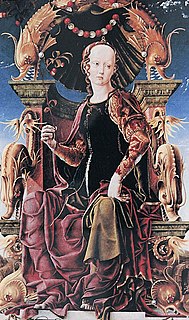
Cosmê Tura, also known as Il Cosmè or Cosimo Tura, was an Italian early-Renaissance painter and considered one of the founders of the School of Ferrara.

Pietro (Libertino) Liberi was an Italian painter of the Baroque era, active mainly in Venice and the Veneto.

Apollodoros was an ancient Athenian red-figure vase painter who was active in around 500 BCE. His name is found on two cups and many more are attributed to him.

Francesco Maffei was an Italian painter, active in the Baroque style.
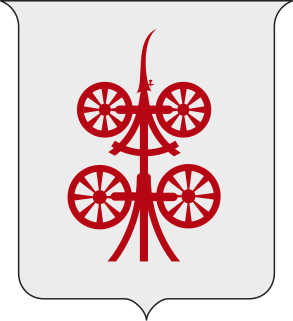
The Carraresi (or da Carrara) were an important family of northern Italy in the 12th to 15th centuries. The family held the title of Lords of Padua from 1318 to 1405.
Giovanni Gioseffo dal Sole was an Italian painter and engraver from Bologna, active in the late-Baroque period. Upon the death of Carlo Cignani, Gioseffo dal Sole became among the most prominent painters in Bologna, described as the Guido Moderno.

Enrico Scrovegni was a Paduan money-lender who lived around the time of Giotto and Dante. He was the son of Reginaldo degli Scrovegni and Capellina Malacapelli, and was married twice, first to a member of the Carrara family, then to Jacopina (Giacomina) d'Este, daughter of Francesco d'Este, Marquis of Ferrara. He may have been a member of the Cavalieri Gaudenti.

Giuseppe Angeli was an Italian painter of the late-Baroque, known for depicting both genre and religious subjects.
Alfonso Rivarola was an Italian painter of the Baroque period, active mainly in Ferrara, where he was born. He is also known as il Chenda because of an inheritance he received from someone with that name.
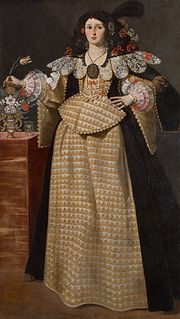
Luca Ferrari was an Italian painter of the Baroque period.
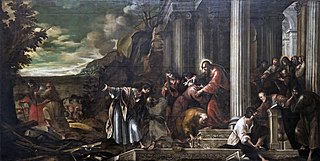
Giovanni Battista Bissoni (1576–1636) was an Italian painter. He was born in Padua. He was first a pupil of Francesco Apollodoro, called Il Porcia, a portrait painter, and afterwards of Dario Varotari the Elder. Bissoni painted for the churches and convents at Padua and Ravenna. In the refectory of the convent of San Vitale, he painted a Last Supper.

Lorenzo Canozzi or Canozio (1425–1477), also called Lorenzo da Lendinara, was an Italian painter of the Renaissance.
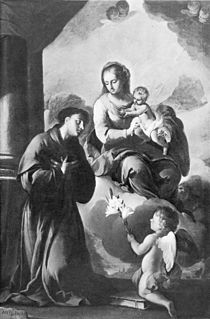
Antonio Paglia was an Italian painter active mainly in Brescia in a late-Baroque or Rococo style. He was the son of the Baroque painter Francesco Paglia. He collaborated with his brother Angelo. He apparently traveled after 1714 to Venice to apprentice with Sebastiano Ricci. By 1718, he had returned to Brescia, where he specialized in painting altarpieces and religious frescos. Among his main works is a large decorative cycle for the parish church of Chiari.
Francesco Nasini was an Italian painter of the Baroque period, active mainly in towns outside of Siena, Italy.

Giulio Cirello was an Italian painter.

Francesco Minorello or Menorelo was an Italian painter of the Baroque period active mainly in Padua.

Francesco Zanella was an Italian painter, active in Padua and painting in a Baroque style.

Giovanni Maria Mosca or Giovanni Padovano was an Italian sculptor and medallist, active between 1515 and 1573, initially in the Veneto and after 1529 in Poland, where his first name was rendered Jan.

The War of Padua was a conflict in 1404–1405 between the Republic of Venice and the Carrarese lordship of Padua. In the power vacuum produced by the death of the Duke of Milan, Gian Galeazzo Visconti, in 1402, Francesco II da Carrara endeavored to expand into the Veneto and capture cities held by Visconti troops. These designs alarmed Venice, which allied with Milan to counter the common threat posed by the Carrarese state, and for the first time adopted a policy of direct intervention in the affairs of its hinterland.
| Wikimedia Commons has media related to Francesco Apollodoro . |